The legacy of Hartlepool's US Navy 'ghost ships'
- Published

Ten years ago, a trans-Atlantic row broke out over the fate of 13 rusting US warships destined to be broken up in Hartlepool. Environmentalists claimed their toxic contents would endanger health but how has the town actually been affected?
Until 2003, if someone was asked where Hartlepool was, the answer might well have been "the place where they hanged the monkey, external".
But on 12 November 2003, the arrival, external of a rusting American warship triggered a saga unequalled in the town's history.
Four months earlier, businessman Peter Stephenson won a contract, external to scrap ageing ex-US naval vessels - dubbed "ghost ships" - at his Able UK yard.
That sparked a bitter environmental and legal fight, which has continued to this day.
Hartlepool-born Mr Stephenson said the contract was for an initial 13 vessels, but he ultimately hoped to dismantle 167 ships at the yard.
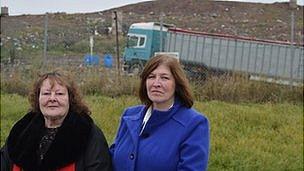
Landfill fight continues: Jean Kennedy, left and Iris Ryder from Friends of Hartlepool
Environmentalists mounted vociferous protests, claiming Hartlepool would become "the dumping ground of the world" but Able UK said the work would provide a much-needed boost to the local economy and create hundreds of new jobs.
The vessels, which had lain in the James River in Virginia for decades, contained hundreds of tonnes of hazardous substances, including asbestos, heavy diesel, mercury, lead-based paints and polychlorinated biphenyls (PCBs).
Five years of complex licensing rows, court cases, external, council meetings and government announcements followed, before work could begin.
In June 2008, the Environment Agency finally issued Able UK with the waste management licence it needed to start dismantling the vessels. The firm had overcome objections from Hartlepool Council, but had been forced to resubmit detailed plans to satisfy the agency that the work would not have a detrimental effect on surrounding wildlife.
But by then, only four ships had actually made it across the Atlantic and apart from a separate deal to scrap a French aircraft carrier, external, any chance of more work from America had disappeared, external.
'Half capacity'
"What stays with me is how a small number of protesters can do so much damage," recalled Mr Stephenson.
"The town lost out on 250 jobs and £120m in wages because of all the delays and the eventual lost contract.
"To give a further indication of what this has meant for us, we have brought in oil and gas drilling rigs over the past five years to the value of about £100m and peaked at about 750 jobs.
"But we are only at half capacity because we're not using our dry dock. There have been two very large jobs which we could have had - one alone would have brought in £100m for five months' work."
However, environmental group Friends of Hartlepool, external, which was formed in 2003 specifically to fight Able UK's plans, remains unrepentant.
It says it is still concerned about the company's Seaton Meadows landfill site, which contains some of the material from the recycled ships.
"The ghost ships were such a hurt to the town," said the group's founder Jean Kennedy.
"It was all forced on us by big business. We were designated as the dumping ground of the world. When we realised what was in the ships we knew it would be detrimental to this little town.
"Hartlepool has suffered a lot over the centuries and we felt this was the final blow to the health, security and welfare of every man, woman and child in this town."
Fellow campaigner Iris Ryder said: "None of the statutory agencies stepped in to put a stop to it, which has meant that Friends of Hartlepool have had to fill that void.
'Totally untrue'
"It has all definitely been worth it though. We could have had the entire fleet over here if we hadn't acted.
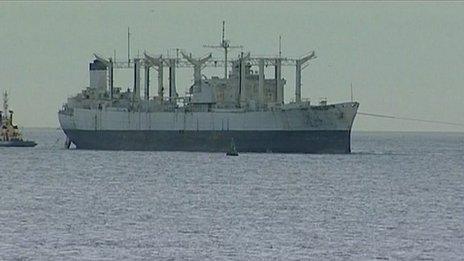
The first "ghost ship" - the Caloosahatchee - arrived on 12 November 2003

Four ships would eventually dock in Hartlepool
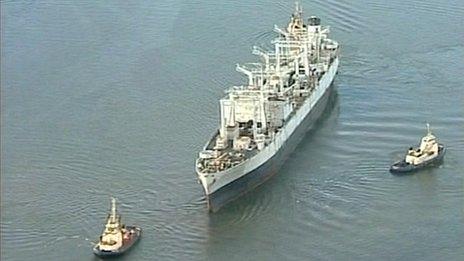
Dutch tugs escorted the first ship into Hartlepool
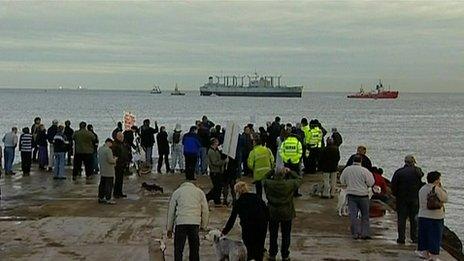
Onlookers joined protesters to greet the first of the "ghost ships" into Hartlepool
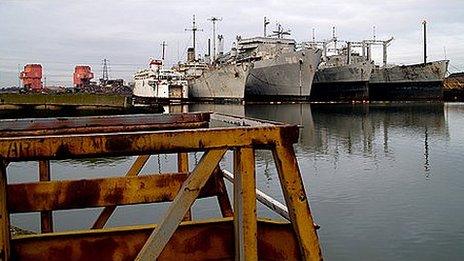
The ships lay idle for five years before dismantling work could begin
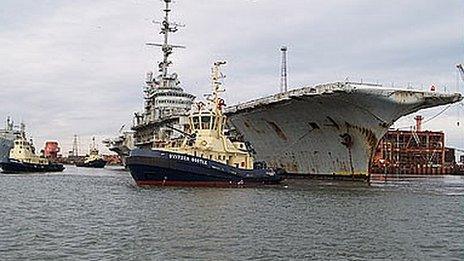
The French aircraft carrier Clemenceau was the only other "ghost ship" to be scrapped at Able UK's yard

The dismantling work was finally completed in January 2011
"It hasn't stopped even now. We're still getting international waste dumped on this town. This isn't waste that we've produced, it is coming in from all over the world."
Friends of Hartlepool are trying to block plans to expand the landfill site.
Mr Stephenson has stressed that the materials in the landfill site, including asbestos, heavy industrial and chemical waste and recycled oil and gas rigs, are safe.
He said: "It has been proven that the concerns about the environmental impact of the American ships were not valid. All the regulatory authorities had gone through the proper processes when we got our original planning permissions.
"These protesters came out making accusations which were totally untrue. There was less than 18 lorry loads of waste from the ships that went to landfill, which was less than 2% of the total tonnage we received. The rest was successfully recycled.
"I am aware that some of the protesters have continued to raise concerns about the material in the Seaton Meadows landfill. But these are unfounded, just as the concerns about the vessels were unfounded.
"I can assure the public that the legislation in the UK and the strictness of the regulatory authorities here ensures that there could never be anything in there that would harm anyone in the surrounding area."
Stuart Drummond, who in 2003 was just a year into his job as the town's mayor, after working as Hartlepool United's on-pitch 'H'angus the Monkey", external mascot, has some sympathy for Able UK.
He said: "I think, knowing Hartlepool very well and, without being detrimental to the area, we are quite an insular town and something like this can get blown up very quickly.
"Rumours spread very quickly and if the right facts aren't portrayed in the first place things can get blown out of all proportion, which I think is what happened with the ghost ships.
"When it came down to it, some of the people involved in the campaign groups were basing a lot of their arguments on hearsay and perception and not very much fact."
But Jean Kennedy and Iris Ryder remain defiant.
"Hartlepool is in our hearts, minds and souls, so we'll fight on to the last drop," said Mrs Kennedy.
"It's been 10 years and we still haven't stopped and we won't stop."
Hazardous material on the 13 ships
Heavy fuel oil:
2,300 tonnes
-
Oily water: 1,881 tonnes
Other oils: 1,907 tonnes
-
Material contaminated with asbestos: 1,916 tonnes
-
Material that may contain PCB: 769 tonnes
Mercury, Cadmium, Chromium and Lead: Quantity not known
Source: Able UK
- Published16 November 2010